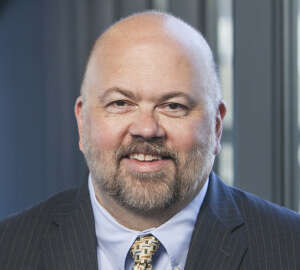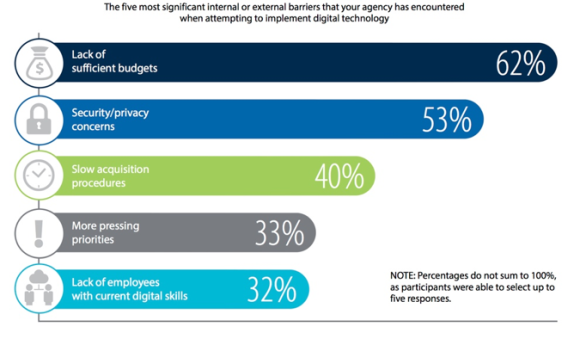

If innovators in industry can do it, why is the government — one of the world’s largest buyers of information technology — lagging behind when it comes to...
This column was originally published on Jeff Neal’s blog, ChiefHRO.com, and was republished here with permission from the author.
With the explosive growth of digital technology and the disruptive innovation it enables, the time is right for digital government to take off. In our home lives, we can hail an Uber from our smartphones, stay in someone’s home using Airbnb and deposit checks to our checking accounts simply by taking a picture of them. If innovators in industry can do it, why is the government — one of the world’s largest buyers of information technology — lagging behind? It isn’t for lack of trying.
Survey data shows some of the reasons, and it is safe to say government is making progress, but we need to address some fundamental talent problems before we can realize the full potential of digital government.
The 2016 Federal Leaders Digital Insight Study, conducted by the National Academy of Public Administration and ICF International, answers that question and offers some ideas on how government can get its digital act together. The Study, based on a survey of 10,000 federal leaders, asked how well the government is doing with digital tech. The answers were surprising. Most respondents (68 percent) said their agencies use digital technology to engage citizens and others and 87 percent believe better access to digital tech will make them more productive. But — 56 percent believe they are not keeping up with innovation in the private sector.

If everyone wants to go digital, why is the government lagging behind? One big reason is money — the budget battles have left agencies without enough money to go big with digital. The study also said security concerns were a big driver. Given that the government suffered a breach at the Office of Personnel Management that let someone get away with personal information on more than 20 million people, feds are understandably gun shy about moving too quickly into the digital realm. Government buying procedures, known for their complexity and sluggish pace, are another big reason, as is just having too many other things to do.
Even if they had the money, did not have the security fears, and could navigate the buying maze, a third of government leaders said they did not have employees with the right skills to pull it off. Without the right talent, they cannot conceive and execute game changing projects.
The botched rollout of HealthCare.gov got the Obama administration’s attention and spurred it to accelerate its efforts to bring government into the 21st century.
One big outcome was the creation in August 2014 of the US Digital Service (USDS). USDS is led by Google veteran Mikey Dickerson, who was one of the digital experts brought in to rescue HealthCare.gov. Dickerson and his team, along with former federal Chief Information Officer Steven VanRoekel, rolled out a Digital Services Playbook, based upon commercial and government successful practices, to help get government’s digital services on track. The White House also published the “TechFAR” to demystify the government’s arcane buying rules and take away the excuse that it was too hard to buy modern digital tech.

Since then, current federal CIO Tony Scott has continued to push for more and better digital technology, with a big focus on dealing with cybersecurity problems and solving the tech talent problems that plague government leaders.
The talent problem is going to be a bigger challenge than Scott or others can solve on their own. The federal hiring system is notorious for being hard to navigate, impossible to understand and a barrier to talented people coming into government. When the government competes with industry recruiters who can make quick offers and pay big signing bonuses and salaries, it has to rely on an interest in public service as its chief recruiting tool. One USDS employee I spoke with told me the opportunity to “make a difference” was the reason he joined the USDS team.
The ability to make a difference may not be enough to get the right tech talent for the government. Acting Health and Human Services Chief Information Officer Beth Killoran said of the hiring process, “It’s broken. We’ve created so much bureaucracy that we’ve put ourselves in a corner where we cannot be competitive … and I think it’s the difference between the federal government and the private sector right now.” The government is competing for tech talent using hiring and pay processes that were designed in the 1950s for a workforce that was mostly clerical. The challenge is particularly tough for hiring younger workers. As I wrote last week, the government now has only 162,000 employees under age 30 — down from more than 233,000 just 7 years ago, while the number of 60+ workers has increased from 224,000 in 2009 to more than 277,000 today.
The lack of younger people entering government might not be a problem if the government was providing existing federal workers with the training they need to keep up with the rapid rate of changes in technology, but that is not happening. In fact, the Study showed that 62 percent of respondents were not adequately training employees to use new technology. We did not ask if the agencies were investing enough to training their tech staff to keep their skills current, but I have yet to talk with a federal employee who says his or her agency is investing enough in training. The government’s inadequate investments in training for its existing workforce and its antiquated hiring practices create a problem the government has to solve if it wants to keep up with the private sector in the rapidly evolving digital world.
Last year, OPM granted all agencies authority to hire digital services talent for a set of “Smarter IT” projects using an excepted service appointing authority. The problem is that the appointments cannot extend beyond Sept. 30, 2017. In and out in 2 years might seem like it isn’t a problem, but no organization, public or private, wants constant churn in its workforce. Add to that the fact that the appointing authority becomes less appealing every day as we get closer to the drop dead date, and we have a hiring authority that is, at best, an interim solution. We need to be able to recruit the right people into government and to keep them. Being able to hire them, only to turn around and send them away next year is not going to solve any problems.
One solution that should be considered is moving all new digital services positions to the excepted service and leaving them there permanently. The excepted service is designed for positions “for which it is not practicable to examine.” It is becoming more and more clear that the hiring process and the competitive talent market make it “impracticable to examine” for these types of positions. The Homeland Security Department was granted this authority for cybersecurity positions in 2014 and according to DHS Secretary Jeh Johnson, still struggles with hiring enough people. Until there is comprehensive civil service reform, use of permanent excepted service authority is certainly justified and is the best and easiest way to address the problem.
Jeff Neal is a senior vice president for ICF International and founder of the blog, ChiefHRO.com. Before coming to ICF, Neal was the chief human capital officer at the Department of Homeland Security and the chief human resources officer at the Defense Logistics Agency.
Copyright © 2025 Federal News Network. All rights reserved. This website is not intended for users located within the European Economic Area.



